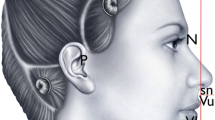Abstract
Background
When evaluating patients’ profile, surgeons usually note the lack of the chin projection and may suggest chin augmentation, but they rarely discuss reduction of an over-projecting chin. This is unfortunate, since there are quite many individuals who have macrogenia and would aesthetically benefit from corrective surgery, but the chin reduction is seldom offered. The reason for this is the lack of experience, lack of the technical equipment necessary, or sometimes lack of knowledge. The present study conveys 25 years of experience with the reduction genioplasty.
Methods
From 1994 to 2019, 47 patients (39 females, 6 males, and 2 male to female transsexuals) underwent 49 chin reduction procedures. All patients were operated and followed up by the author. The transoral approach was used in 23 patients, and in 24 patients the procedure was done through the straight 4- to 6-cm-long submental incision. The air-driven pneumatic chisel was employed for reduction of the mandibular bone (MicroAire, Charlottesville, VA, USA). Forty-eight operations were carried out under dissociative and local anaesthesia on an outpatient basis, and one procedure was done under general endotracheal anaesthesia.
Results
Both mandibular bone and the soft tissues of the chin were reduced, or modulated according to the needs of each patient. Operations were technically easier when executed by the submental approach because of better exposure of the mandibular rim and the higher precision in the remodelling of the soft tissues. Thirty-six patients (77%) could be followed up for a mean of 2.5 years (range 9 months to 12 years). Twenty-eight of evaluated patients (78%) described the outcome as very good or good. Four patients described the result as acceptable and another 4 as bad. In the majority of cases the evaluation by the surgeon correlated well with the opinion of patients, but in five cases surgeon estimated result with the higher score than the patient. Overall good results were illustrated by the photographs of the clinical examples. Complications were few and manageable. Transient neuropathies were common and more frequent with the transoral approach. Five patients required minor intervention for skin indentations at the jaw line developed during the healing phase.
Conclusions
Skilful chin reduction surgery is safe and the aesthetic improvement could be quite spectacular, which is also rewarding for the patients. Complications in this patient series were few and manageable. More surgeons should include chin reduction in their repertoire.










Similar content being viewed by others
References
Niechajev I (2012) Facial reconstruction using porous high-density polyethylene (Medpor): long-term results. Aesthet Plast Surg 36:917–927
American Society of Plastic Surgeons (2012) Chin surgery skyrockets among women and men in all age groups http://www.plasticsurgery.org/ News-and-Resources/Chin-Surgery/ April 17
Lee EI (2013) Aesthetic alterations of the chin. Semin Plast Surg 27(3):155–160
Guyuron B, Weinfeld AB (2012) Genioplasty in E-book aesthetic plastic surgery. Video atlas Saunders pp 179-197
Ho C-T, Huang C-S, Jo J-L (2012) Improvement of chin profile after mandibular setback and reduction genioplasty for mandibular prognathism and long chin. Aesthet Plast Surg 36:1198–1206
Park MC, Kang M, Lim H, Lee IJ, Shin SJ (2011) Mandibular tubercle resection : a means of maximizing the benefits of reduction mandibuloplasty. Plast Reconstr Surg 127:2076–2082
Feldman JJ (2003) Chin surgery III: revelations (discussion). Plast Reconstr Surg 111:1551–1552
Guyuron B (2008) Genioplasty. Plast Reconstr Surg 121(Apr 4 Suppl): 1-7. https://doi.org/10.1097/01.prs.0000305931.98111.c3
Rosen HM (1991) Aesthetic guidelines in genioplasty: the role of the labiomenthal fold. Plast Reconstr Surg 88:760–767
Zide BM, Pfeifer TM, Longaker MT (1999) Chin surgery I. Augmentation- the allures and the alerts. Plast Reconstr Surg 10(104):1843–1853
Zide BM, Boutros S (2003) Chin surgery III: revelations. Plast Reconstr Surg 111:1542–1549
Niechajev I, Haraldsson PO (1996) Two methods of dissociative anaesthesia for rhinoplasty in outpatient setting. Aesthet Plast Surg 20:159–163
McKinney P, Rosen PB (1982) Reduction mentoplasty. Plast Reconstr Surg 70:147–152
Zide BM (2000) The mentalis muscle: an essential component of chin and lower lip position. Plast Reconstr Surg 105:1213–1215
Warren SM, Spector JA, Zide BM (2007) Chin surgery V: treatment of the long nonprojecting chin. Plast Reconstr Surg 120:760–768
Gonzales-Ulloa M (1962) Quantitative principles in cosmetic surgery of the face (profileplasty). Plast Reconstr Surg 29:186–198
Rosen HM (1995) Aesthetic guidelines in genioplasty: the role of facial dysproportions. Plast Reconstr Surg 95:463–469
Trauner R, Obwegeser H (1957) The surgical correction of mandibular prognatism and retrognathia with consideration of genioplasty. Oral Surg 10:677-18. 689
Zide BM, Warren SM, Spector JA (2007) Chin surgery IV: the large chin—key parameters for successful chin reduction. Plast Reconstr Surg 120:530–537
Zide BM, Longaker MT (1999) Chin surgery: I I. Submental ostectomy and soft- tissue excision. Plast Reconstr Surg 104:1854–1860
Rustemeyer J, Lehman A (2013) Reduction genioplasty enhances quality of life in female patients with prognathism and maxillary hypoplasia undergoing bimaxillary osteotomy. J Oral Maxillofac Surg 42:1083–1092
Author information
Authors and Affiliations
Corresponding author
Ethics declarations
Ethical approval
All procedures performed in studies involving human participants were in accordance with ethical standards of the institutional and/or national research committee and with the 1964 Helsinki Declaration and its later amendments or comparable ethical standards.
Patient consent
Informed consent was obtained from all individual participants in this study.
Conflict of interest
The author declares that he has no conflict of interest.
Additional information
Publisher’s note
Springer Nature remains neutral with regard to jurisdictional claims in published maps and institutional affiliations.
Rights and permissions
About this article
Cite this article
Niechajev, I. Reduction genioplasty for mandibular prognathism and long chin. Oral Maxillofac Surg 24, 333–341 (2020). https://doi.org/10.1007/s10006-020-00853-8
Received:
Accepted:
Published:
Issue Date:
DOI: https://doi.org/10.1007/s10006-020-00853-8




